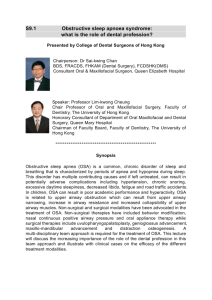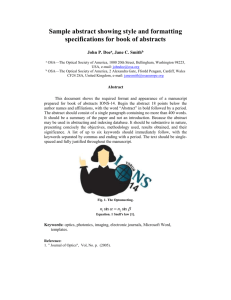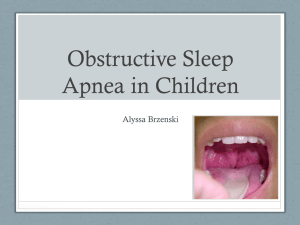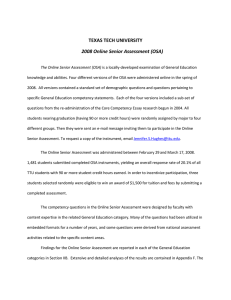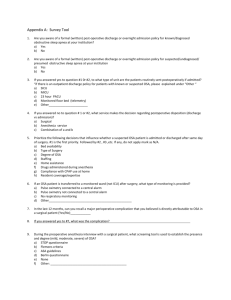Obstructive Sleep Apnea and Upper Airway Resistance Syndrome
advertisement
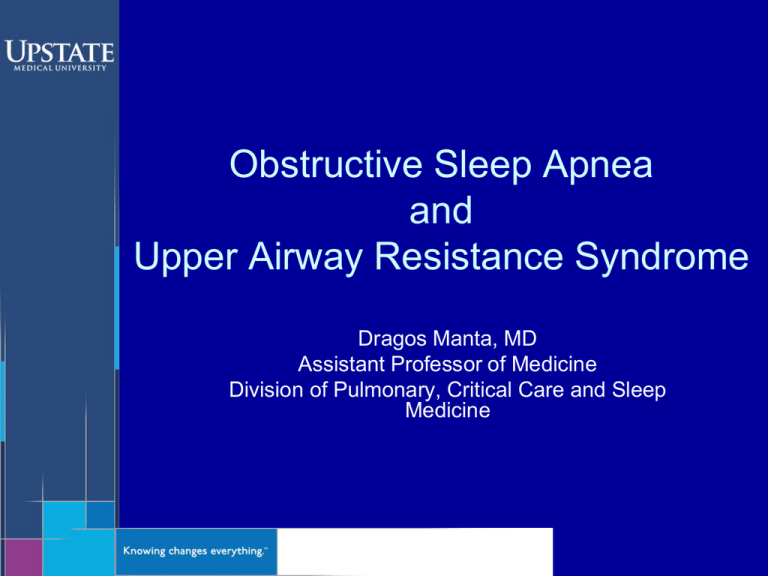
Obstructive Sleep Apnea and Upper Airway Resistance Syndrome Dragos Manta, MD Assistant Professor of Medicine Division of Pulmonary, Critical Care and Sleep Medicine Sleep Architecture What is Obstructive Sleep Apnea (OSA) ? • Intermittent partial or complete airway collapse during sleep • Leading to – Frequent night-time arousals – Sleep Fragmentation – Decreased oxygen levels – Non-restorative sleep Daytime Consequences • Causes excessive daytime fatigue (EDF) and sleepiness (EDS) – Increased risk of motor vehicle accidents – Decreased work productivity Other Daytime Consequences • Increased risk of complications following sedation/anesthesia for procedures/surgery • Tell your anesthesiologist if you have OSA • Bring you machine for procedures/surgery Long Term Consequences • Increased cardio-vascular risk – Hypertension and diabetes – Myocardial infarction/ Coronary artery disease – Atrial fibrillation recurrence after cardioversion/ ablation – Strokes – Dementia – Erectile dysfunction Who Is At Risk? • • • • • Obese Men over 40 Women post-menopausal Non-Caucasian race Elderly (more than 40% of people over 65 have OSA) • Children – enlarged tonsils/adenoids Symptoms of OSA • Snoring • Apneic episodes observed by bed partner • Unexplained nighttime arousals • Agitated sleep • Insomnia • Nocturia • Non-restorative sleep • Morning headaches • Drowsiness • Excessive daytime sleepiness • Need to take naps • Excessive caffeine usage Signs of OSA • Narrow airway • Thick neck (usually over 16 inches in women and 17 inches in men) • Swelling of the lower extremities Other Signs of OSA • • • • Difficult to control blood pressure Difficult to control blood sugars Recurrent atrial fibrillation Fluid retention Testing for OSA • In-lab sleep study • Ambulatory monitoring or portable studies – in patients with high risk for OSA and no other medical problems – Caveat: does not rule it out 2 min of Sleep in OSA Upper Airway Resistance Syndrome (UARS) UARS-Definition • Increased upper airway resistance during sleep that leads to arousals and sleep fragmentation • Without causing partial or complete airway collapse OSA R. G. Norman, D M. Rapoport et al. Sleep 1997 UARS R. G. Norman, D M. Rapoport et al. Sleep 1997 Why UARS? • Associated with functional somatic syndromes – Fibromyagia – Chronic fatigue syndrome – Migraine headaches – Irritable bowel syndrome • Associated with insomnia Demographics of UARS • Tend to be younger than typical OSA patients • BMI can be normal or lower than of patients with OSA • Women and men equally affected Symptoms UARS • • • • Snoring is not universal Have a lot of nighttime arousals Tend to have superficial sleep Patients are sleepy like most OSA patients • Fatigue rather than sleepiness in some patients Fatigue vs Sleepiness • Characterized by • Sleepiness means the physical exhaustion propensity of falling asleep • Worse in the morning and • Worse in the evenings afternoon Insomnia and OSA/UARS Wickwire, Emerson; Collop, Nancy. Chest. 137(6):1449-1463, June 2010 Treatment of OSA/UARS • • • • • PAP (positive airway pressure) Oral Appliances Surgery Adjunctive therapies Emerging therapies CPAP – GOLD Standard CPAP • Most efficacious option • Most commonly prescribed • Acts as a “pneumatic splint” splinting the upper airway and preventing airway collapse during sleep. • Immediate improves sleep • Improves quality of life, daytime sleepiness • Improves hypertension control • Improves glycemic control in patients with diabetes CPAP Prescription • A fixed pressure is prescribed after – Titration during monitored overnight PSG – Auto-CPAP trial CPAP pressure • • • • Severity of OSA Body position Weight Sleep stage ( N2 and REM sleep require highest pressures) Auto-CPAP or APAP • For high pressure intolerance • For OSA concentrated by – sleep stage (N2, REM) – position (supine) Morgenthaler TI et al. Practice parameters for the use of autotitrating continuous positive airway pressure devices for titrating pressures and treating adult patients with obstructive sleep apnea syndrome: an update for 2007. An American Academy of Sleep Medicine report. Sleep. 2008;31(1):141-147. • Certain APAP devices may be initiated and used in the selfadjusting mode for unattended treatment of patients with moderate to severe OSA without significant comorbidities (Option) BIPAP • Offers no significant advantage over CPAP for OSA patients (Gay PC et al. Sleep. 2003;26(7):864-869) • For patients that require high pressures of CPAP > 15 cm H2O • For patients intolerant to CPAP due to perceived difficulties with exhalation • For patients with OSA and OHS or COPD Masks Interfaces • Nasal masks are the standard of care • Nasal inserts (“pillows”) are popular • Nasal-oral (full face) masks Follow Up after Initiation of CPAP • Office visit • Data Download – Compliance – Residual apneic episodes – Mask Leaks Oral Appliance (OA) Therapy • Mandibular Advancement Devices (MADs) Effectiveness of MADs • No significant difference between OAs and CPAP in the percentage of mild OSA patients achieving their target AHI/RDI. • For moderate to severe OSA, however, the odds of achieving the target AHI were significantly greater with CPAP than with OAs. Summary of Recommendations AASM 2015 • OAs are recommended for – primary snoring after OSA is ruled out by sleep physician – Patients with OSA who are intolerant of CPAP therapy or prefer alternate therapy • Qualified dentist use a custom, titratable appliance over non-custom oral devices • Sleep physicians and qualified dentists provide follow up Summary of Recommendations AASM 2015 • Sleep physicians conduct follow-up sleep testing – – – – To document or improve treatment efficacy If patients develop recurrent symptoms If substantial weight gain With diagnoses of comorbidities relevant to OSA • Impact of OAs on resistant HTN or long term consequences of OSA not well studied Surgical Treatment • Apart from tracheostomy, surgery is less predictable and effective • Counseling about alternative therapies, success rates and complications • Can be considered for selected patients that failed or not willing to consider PAP and OA therapy • Further research is needed to clarify patient selection, safety and efficacy of surgical approaches for OSA Adjunctive Therapies • Weight loss should be advised for all obese patients with OSA – Caveat: the magnitude of correlation of OSA severity and weight is greater with weight gain rather than weight loss • Bariatric surgery related weight loss provides either resolution of OSA (around 40%) or major improvements of AHI, sleep architecture, CPAP requirements and daytime sleepiness Adjunctive Therapies • Exercise – Sedentary lifestyle associated with OSA • Avoidance of alcohol or sedatives before bedtime Positional Therapy • For purely supine apnea • Tennis ball sawn in a back pajama pocket • Commercially available devices that prevents rolling to supine position • Objectively document effectiveness with position monitor 3 New FDA-Approved Therapies • Nasal expiratory PAP devices (Nasal EPAP) • Oral pressure therapy (OPT) • Electrical Stimulation (ES) Nasal Expiratory PAP Devices • Unidirectional flow resistance valves • Expiratory flow resistance without any inspiratory resistance • For Mild OSA Oral Pressure Therapy (OPT) • Gentle oral suction sufficient to displace the soft palate and the tongue anterior and superior • For mild OSA Electrical Stimulation (ES) Electrical Stimulation (ES) • Promising for moderate and severe OSA in non-obese patients • Adherence was improved • For selected patients • ?Long term efficacy and side effects Thank You! Questions?
